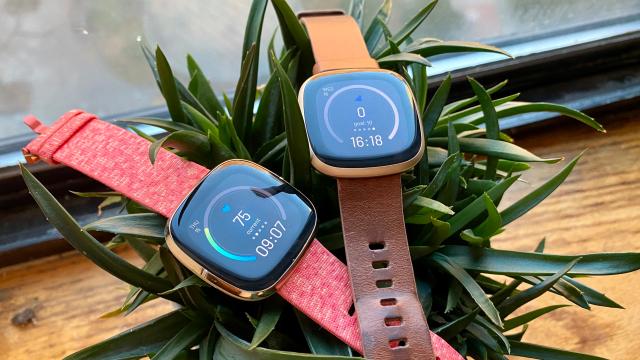Earlier this year, Fitbit threw down the gauntlet with the ambitious Fitbit Sense and a revamped Versa 3. But while these gadgets launched a few months ago, some of the marquee features teased in August were still MIA. Well, not anymore. Fitbit OS 5.1 is landing today for U.S. users and the updates included are some of the most substantial we’ve seen in a long time.
For starters, you can now use Google Assistant on the Sense and Versa 3, making this perhaps the first smartwatch that lets you choose between two of the three major digital assistants. Samsung locks you into Bixby, a nothingburger assistant that might soon take a backseat to Google Assistant on Samsung’s own phones. The Apple Watch forces Siri, another incompetent dingus, down your throat. And until now, Google Assistant for the wrist was largely limited to Wear OS devices. Fitbit introduced Amazon Alexa to its devices with the Versa 2 last year, but this update gives you options.
The ability to choose is major, and the pending Google-Fitbit merger probably had something to do with Fitbits gaining Google Assistant compatibility. It’s also great news for Android users, as it gives them several more options for a full-featured smartwatch with fewer trade-offs. While Samsung’s Galaxy smartwatches are great, many of the best features are only for users with Samsung phones. Meanwhile, Wear OS slots nicely into Google’s ecosystem but is the ugly stepsister of smartwatch platforms.
To enable Google Assistant, you first have to download the Fitbit OS 5.1 update. Once that’s done, you can tap Account on the top left of the Fitbit app. You then select either the Sense or Versa 3, choose Voice Assistant, select Google Assistant, and then log in to Google to link accounts. Unfortunately, as with the Fitbit OS 5.0 update, this is only for the Versa 3 and Sense. Versa 2 users are out of luck. A Fitbit spokesperson told Gizmodo that the omission is due to the fact that the Versa 2 doesn’t have a speaker.
Alexa on the Sense and Versa 3 is also getting a boost. On the Versa 2, Alexa queries resulted in silent answers on your wrist. (Honestly…that’s preferable in my humble opinion.) However, now you can get audible replies as well from the Sense or Versa 3’s built-in speaker.
Another big update is that both iOS and Android users will be able to take calls directly on the wrist, provided their phone is nearby. No Fitbit so far has cellular capability, so this is more for instances when your phone is in another room. Android users get a little bit extra — they can now respond to text messages with voice-to-text commands.
Lastly, Fitbit’s also tweaking its SpO2 features for both watches. Previously, in order to get SpO2 readings, you had to download the SpO2 clock face. (This doesn’t apply to Estimated Oxygen Variation readings, which also utilise the SpO2 sensors.) It was frankly kind of annoying, given that sort of nerfs the whole point of having a huge gallery of clock faces. However, Fitbit OS 5.1 will make SpO2 readings at night automatic — meaning you don’t have to use a specific clock face to get that metric. Fitbit also says it’s adding seven more SpO2 clock faces to the App Gallery by the end of the year, in case you want an SpO2 clock face but don’t particularly like the one option currently available.
These are all good features, but this update is especially great for anyone looking for more affordable alternatives to the premium flagship smartwatches out there. The Fitbit Sense is the more expensive of the two, and that’s $499 — $100 cheaper than the GPS-only 40mm Apple Watch Series 6 and the same as a cellular 40mm Apple Watch SE.
It’s also cheaper than the $699 Bluetooth Galaxy Watch 3, which is currently the best full-featured smartwatch for Android users with Samsung phones. It was a major disappointment when Samsung revealed earlier this fall that non-Samsung smartphone users would not get the ECG app, which can take electrocardiograms cleared by the U.S. Food and Drug Administration. The Fitbit Sense can take ECGs regardless of smartphone platform, and given today’s updates, the Sense is now more of a compelling alternative for Android users. Not to mention those who don’t give a flying hoot about ECGs can also opt for the even cheaper $325 Versa 3 without giving up SpO2-tracking.
Honestly, today’s update is a huge step toward closing the gap between Fitbit and Samsung. At this point, the main things holding Fitbit back from snatching the “Best Smartwatch for Android” title are design (no one really loves a squircle Apple Watch clone) and the lack of LTE. Fix that, and maybe Android users will finally get a smartwatch that ticks off all the right boxes.
